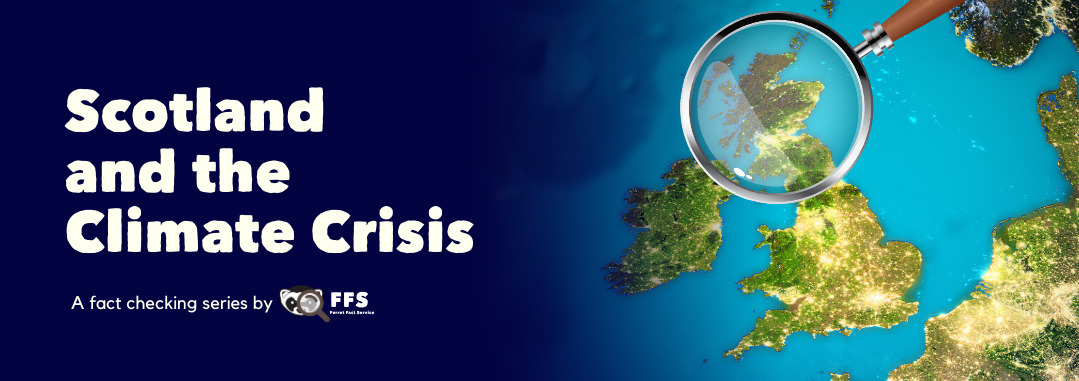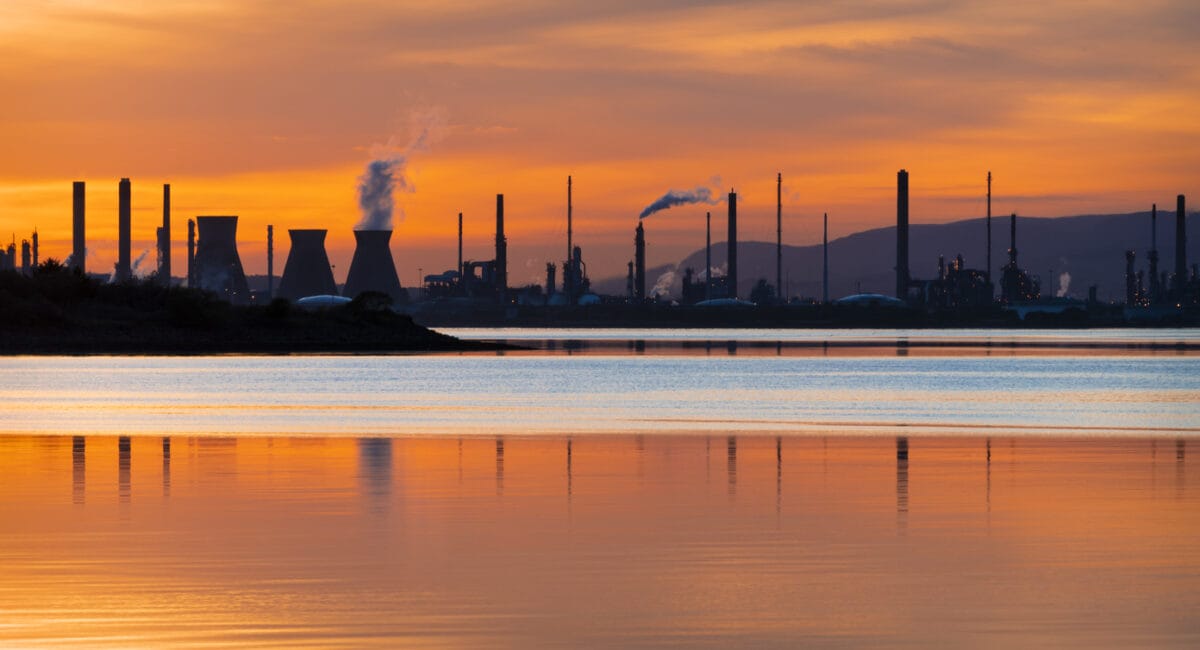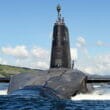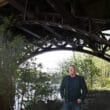
The jargon around climate change can be confusing and alienating.
As part of The Ferret’s climate fact checking series we asked our readers to suggest climate terminology they wanted explained.
Adaptation
Solutions and changes that will be made to help the world adapt to the impacts of a heating climate. These impacts will include sea level rise, drought, flooding, and extreme weather.
Examples of potential adaptations are early weather warning systems, the building of flood defences and the development of drought resistant crops.
Albedo effect
An object’s albedo is its ability to reflect sunlight. Light coloured surfaces reflect more sunlight than dark coloured surfaces.
Very white surfaces, such as fresh snow, reflect more sunlight back into space. This is important in the context of climate change, because ice sheets are melting, meaning that Earth’s land is absorbing more sunlight. This in turn leads to further global warming.
Biodiversity loss
Biodiversity refers to the variety of animals, plants and other organisms which exist on Earth. Maintaining biodiversity is vital to human life because it creates the environmental conditions that allow us to survive. Biodiversity loss refers to the decline or disappearance in the diversity of living things on the planet.
The world is currently in a biodiversity crisis. Wildlife populations, for example, decreased by an average of 69 per cent between 1970 and 2018. There are a number of causes of biodiversity loss, including the growing use of land for food production, overfishing and overhunting, along with the climate crisis.
Biofuels
A biofuel is any fuel which is made out of living things such as plants, algae or animal waste. It is considered a renewable form of energy, but is not without controversy. It has been used as a means to help reduce emissions from the transport sector, which makes up 24 per cent of all direct carbon dioxide (CO2) emissions from fuel.
Studies have called into question whether biofuels are truly carbon neutral, due to the emissions associated with growing and manufacturing, and the CO2 emitted when it is burned for fuel.
Carbon capture and storage
Carbon capture and storage, also known as CCS, aims to reduce carbon emissions by capturing carbon from industrial processes which would usually be released into the atmosphere.
Captured carbon is stored in a safe location, often deep underground. While many governments and companies have put CCS at the centre of their climate plans, there is disagreement over the technology including its effectiveness and whether it will be ready in time to counteract many of the effects of climate change.

Carbon credits
A carbon credit is a token which represents the removal of greenhouse gas emissions. They can be bought by organisations or individuals to offset emissions that can’t currently be avoided. Each carbon credit is meant to be equivalent to one tonne of greenhouse gas emissions permanently removed from the atmosphere.
Companies buy these credits to offset emissions they cannot avoid in their own processes.
Off-setting strategies can include things like forest restoration. Critics of off-setting have suggested that many offsetting projects do not sufficiently mitigate the source emissions, and it has been described as a “dangerous distraction” as they enable businesses to continue releasing greenhouse gases while appearing to be supporting climate solutions, rather than tackling their own emissions.
Carbon footprint
A carbon footprint is the amount of carbon released into the atmosphere as a result of a person’s actions and activities. The term is also used to describe the carbon emissions of larger entities such as buildings, organisations, industries or countries. It is meant to show the emissions that are associated with consumption.
It includes direct emissions, such as the carbon emitted during transport or in producing food and clothing, as well as indirect emissions like the carbon released providing electricity for goods and services used. It is usually measured by weight per year.
Carbon tax
Carbon taxation is where polluters have to pay a set price to the government for each ton of greenhouse gases they produce.
The aim of carbon taxes is to reduce emissions by incentivising polluters to switch to using cleaner fuels to avoid the tax.
Carbon sink
A carbon ‘sink’ is something that absorbs carbon from the atmosphere, without releasing as much back in. This means it has a net negative impact on the amount of carbon in our atmosphere. Examples of carbon sinks include vegetation, forests, soil, peatlands and seas. The protection and expansion of natural carbon sinks forms a significant part of efforts to fight climate change.
Climate justice
The climate crisis does not affect the world equally, and many of the communities that are most impacted are already economically worse off. Responsibility for historic and current emissions is also unbalanced, with richer countries more likely to have caused emissions driving climate change.
People who are less privileged – due to factors such as ethnicity, gender, class and age – are likely to be more affected by climate change. The concept of climate justice focuses on tackling climate change as part of a plan to end these inequalities in society.
Even within the same country or city, people with less privilege in society are likely to be worst affected by climate change. The logic also applies on an intergenerational basis: young people and future generations have contributed least to rising temperatures but will suffer most from extreme outcomes over the course of this century.
Climate transition
The period in which countries and companies are adopting new practices, consumption habits, and technologies to reduce their impact on the climate.
Deforestation
Cutting down swathes of forest, often to create space for farming or to keep up with demands for timber, has a major impact on climate change. Forests cover more than 30 per cent of the globe, but the World Bank has estimated that 1.3 million square km of forests have been destroyed since 1990. Forests play a central role in absorbing carbon dioxide from the atmosphere.
Degrowth
An economic theory which argues that countries’ should stop pursuing growth as the main measure of economic success.
Degrowthers argue that the pursuit of growth – where nations increase their production of goods and services each year – is driving the climate crisis.
They believe that developed countries should scale down “unecessary production” to limit their resource and energy use and reduce their impact on the environment.
El Niño and La Niña
El Niño is the term used to describe warming of surface waters in the eastern tropical Pacific ocean, while La Niña refers to the unusual cooling of the region’s surface water.
Together they are part of the El Niño-Southern Oscillation (ENSO) which has a significant impact on ocean temperatures, ocean currents, weather and fisheries across the world. El Niño occurs irregularly at between two and seven-year intervals, and can be hard to predict.
Emissions targets
National or international targets which have been set to reduce the amount of greenhouse gases which are put into the atmosphere. Most countries, including all those in the Paris Agreement, have developed climate change plans which set emissions reduction targets across different sectors. There is disagreement on how plans should be laid out and enforced, as well as the pace at which different nations are willing to cut their emissions.
Greenhouse effect
The greenhouse effect occurs in the Earth’s atmosphere when gases trap heat from the sun. It is a natural process that heats up the temperature on the Earth’s surface and is crucial for life to survive. However, human-caused emissions of gases which cause the greenhouse effect have increased significantly, trapping more of the sun’s heat in the atmosphere and increasing global temperatures.
Greenhouse gases
Greenhouse gases trap heat inside the atmosphere, and have the effect of warming the Earth. They are called ‘greenhouse gases’ because they effectively act like the walls of a greenhouse.
While greenhouse gases are natural, human activity dramatically increases the amount of gases which are released into the atmosphere. Scientists agree this is the cause of global warming and climate change. The most common of these gases is carbon dioxide, which is the main emission from burning fossil fuels such as oil, coal and gas. Methane and nitrous oxide are also major greenhouse gases.
Green washing
‘Green washing’ is a marketing tactic where companies make false or exaggerated claims about how environmentally friendly their products are.
An oft-cited example is oil companies advertising their spending on renewable energy, while at the same time maintaining far larger investments in fossil fuels.
Ice loss
The rate of decrease of ice on Earth is one of the most recognisable markers of climate change. According to research Earth lost 28 trillion tonnes of ice between 1994 and 2017, and ice loss appears to have markedly increased in the past 30 years.

Isotopic fingerprint
Scientists can measure carbon isotopes to identify the source of carbon in the atmosphere. CO2 that is produced from fossil fuels being burned has a different isotopic composition from carbon dioxide in the atmosphere. This is one of the methods climate experts can use to prove that humans are causing carbon emissions which are worsening the greenhouse effect.
Just transition
The concept of a just transition was developed by trade unions to highlight the need to protect workers and communities as the shift is made to a more environmentally friendly economy.
For example, in Scotland, an important part of the ‘just transition’ will be ensuring there are jobs for North Sea oil workers in green industries. The concept of the just transition is embedded in Scotland’s plan to tackle climate change.
Milankovitch cycles
Changes in Earth’s position relative to the sun that scientist Milutin Milankovitch suggested could explain some of the long-term differences in global climate. This is because of slight differences to the amount of the sun’s energy that is absorbed.
These orbit changes are thought to be the reason that Earth has shifted between glacial periods, where ice covers much of the northern hemisphere, and interglacial times where ice has been restricted to the poles.
They occur between 23,000 and 110,000 years apart, and do not account for the rapid warming in the last century caused by human impacts on greenhouse gas emissions.
Net zero
To achieve net zero, there needs to be a balance between the amount of greenhouse gas emissions and the amount removed from the atmosphere. This can be done through reducing existing emissions and actively removing greenhouse gases from the atmosphere.
Reaching net zero is the aim of countries who signed up to the Paris Climate Agreement, who are aiming to limit global warming.
Off-setting
Carbon off-setting is the concept of removing carbon or other greenhouse gases from the atmosphere to compensate for emissions made elsewhere. Usually it refers to businesses or countries paying other firms to reduce carbon emissions when they cannot or do not want to reduce emissions in their own processes. They often then count these emission reductions towards their own targets.
Ozone layer
The Ozone layer is a thin part of the Earth’s stratosphere which absorbs harmful rays from the sun. It makes up a very small part of the atmosphere, but has a very important impact. It is particularly effective at trapping ultraviolet radiation (UV light), which can cause damage to plants and animals, and is one of the leading causes of cancer in humans.
The Ozone layer has been impacted by the use of chlorofluorocarbons (CFCs), a molecule often used in refrigerators, plastic products and aerosol sprays. This chemical was effectively banned in Montreal Protocol, agreed in 1987, which phased out the use of CFCs across most of the world. This has enabled the ozone layer to repair itself and it is expected to return to 1980 levels between 2045 and 2060, if countries continue to phase out the final ozone-depleting substances in coming years.
Paris Agreement
A legally-binding treaty on climate change, it was adopted by 196 countries in 2015 at COP21. It aims to keep warming at 1.5 degrees, and countries agreed to be held to targets to reduce their emissions across sectors. Nations who signed up to the agreement have to develop climate change plans (NDCs) which they are committed to achieving.
Peat restoration
Peatlands are very important in the mitigation of climate change. They are the biggest natural carbon store on earth. When they are damaged, peatlands are a major source of greenhouse gas emissions. Scotland has set targets for peatland restoration as part of its climate plans.
Scope 1 2 3
When reporting on their greenhouse gas emissions, companies split emissions into three different ‘scopes’.
Scope 1 emissions are those from sources that a company owns directly – for example from fuel used by its fleet of vehicles.
Scope 2 are emissions that a company causes indirectly when the energy it uses is produced – for example the electricity it uses in its offices.
Scope 3 emissions are indirect emissions produced in a company’s supply chain.
Sea level increase
Climate change is causing sea levels to rise across the globe. This is caused by two factors.
The first is that warmer global temperatures cause ice sheets and glaciers to melt, which adds more water to the ocean. Secondly, rises in the ocean temperature causes seawater to expand which causes water levels to rise.
Sustainability
Activities are environmentally sustainable if they maintain the balance within Earth’s natural environment and conserve natural resources for use by future generations.
Governments and businesses have rolled out a range of policies in recent years aimed at achieving sustainability.
Tipping point
When our impact on the climate reaches a point where we do irreversible damage to an element of our environment – with enormous knock-on effects. There are a number of potential tipping points cited by scientists including the loss of the Amazon rainforest, the melting West Antarctic ice sheet, and the Gulf stream current stopping, which helps to regulate the climate in Scotland.
Volcano activity
Regularly cited as a cause of climate change, due to the CO2 released into the atmosphere by eruptions, but volcano activity releases a relatively small amount of CO2 during eruptions. According to NASA, human activity emits the same amount of CO2 as the eruption of Mount St Helens every two and a half hours.














